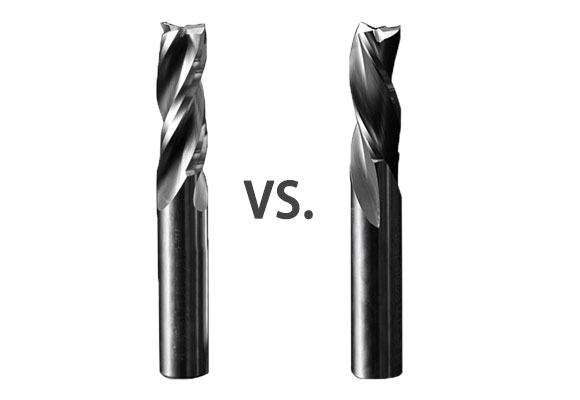
Upcut vs. Downcut Router Bits
In woodworking projects, the right tooling choice is essential for creating ideal results, especially in CNC cutting. However, it is not an easy decision to make. One of the most confusing and frustrating choices is between upcut and downcut router bits. With different flute directions, upcut and downcut bits can achieve different cutting results. This article explains the difference between upcut router bits and downcut router bits. Next time when you are selecting a spiral router bit, you can easily make the decision on your own.
What is an upcut router bit?

If you take a close look at an upcut bit, you can notice that the direction of the flutes goes up from left to right. With this design, wood chips are removed up and out of the cut, leaving a clean and smooth bottom surface of the workpiece. Besides, they allow for a faster cut speed because of the efficient removal of chips. Upcut bits can stay sharper for a longer time since there isn’t a buildup of chips and dust in the cut. However, upcut spiral bits result in a frayed top surface of the workpiece. This type of bit is commonly used in producing mortises and deep grooves or blind holes.
What is a downcut router bit?

Contrary to the upcut router bit, a downcut bit features downward flutes from left to right. Downcut spiral bits slowly evacuate wood chips downward, leaving a very crisp and clean top edge without any fraying and splintering. Unlike an upcut spiral router bit which throws chips out directly, a downcut router bit requires a relatively slower cut speed because it needs more time to remove those chips. If a downcut bit works at a very fast speed, a build-up of wood chips inside the groove may cause overheating or even break the bit. Downcut bits are suitable for creating shallow grooves or dados on veneers or laminates to prevent tear-out on the top surface. It is also ideal for sizing, trimming, and pattern cutting. However, the bottom edge can be frayed as the chips are going downward and continuously recut.
Differences between upcut and downcut bits
Now that we have a clear understanding of upcut bits and downcut bits, we can easily list their differences.
Chip removal: The most obvious difference between upcut and downcut router bits is the direction of the flutes. Upcut bits have upward flutes, throwing chips up and out of the cut. While downcut bits have downward flutes, pushing chips down into the cut.
Cut results: Upcut bits can leave a nice and clean top surface, thus suitable for producing deep grooves or dados. On the other hand, downcut spiral bits are perfect for creating shallow grooves or slots on veneers or laminates because they can leave a clean and crisp top surface.
Cutting material: Upcut bits are designed for cutting wood, plastics, and aluminum, but downcut bits are more appropriate for cutting veneer, laminates, and plywood.
Durability: Due to the buildup of chips in the cut, downcut bits can be dull more quickly than upcut spiral bits which remove chips more efficiently.
Which one to use?
It depends on the project. When you need to create shallow slots, grooves, rabbets, and dados and the top edge is going to be visible, it’s wise to use a downcut bit. When you plan to cut deep holes and the top edge is not going to be seen, an upcut bit is your choice. However, there are times when you need both the top and bottom edges to be clean and nice. Here comes the compression bit.
What is a compression bit?

A compression bit is often used in CNC cutting. It combines upcut and downcut, thus called “compression”. With a compression bit, it’s easy to create a smooth and clean edge on both sides of the workpiece. The upcut section pulls out the chips quickly and the downcut section smooths the top and bottom edges. However, a compression bit is more expensive and requires professional techniques. If you have enough budget and know how to use it correctly, a compression bit is definitely your best choice to produce clean edges.
Konetool supplies a full range of industrial-quality spiral router bits. We have rich experience in the B2B sales of router bits. If you’re looking for a reliable router bit supplier, please feel free to contact us at: [email protected] for further information, including minimum order quantity (MOQ), price, payment, delivery, etc.